Hudson River Almanac 3/8/19 - 3/15/19
The New York State Department of Environmental Conservation sent this bulletin on 03/22/2019 02:00 PM EDT |
| DEC Delivers - Information to keep you connected and informed from the NYS Department of Environmental Conservation |
| Share or view as a web page || Update preferences or unsubscribe |
Hudson River Almanac
|
Compiled by Tom Lake, Hudson River Estuary Program Consulting NaturalistOverviewIt was a week of harp seals, harbor seals, bald eagles wintering here from far-away places, and the upriver run of glass eels picking up its pace. In another sign of impending spring, we offer an advisory on the care of amphibians as they cross our roadways on warm, damp, spring nights. Highlight of the Week
[Harp seals (Pagophilus groenlandicus) are native to north Atlantic and Arctic waters occasionally finding their way south and even less commonly into the Hudson River. The upper estuary was visited by a harp seal last April (2018). That one was an adult with a diagnostic black “splotch” on its back (pelage), a Rorschach-like image suggesting a harp. Tom Lake] Natural History Entries3/8 – Hudson River Estuary: The New Jersey Hudson River Fishermen’s Association announced their 2018 Hudson River catch-and-release fishing contest winners. Among fishes caught in the Hudson River, frequent Hudson River Almanac contributor and master angler, Bill Greene, placed first in the common carp category with a 25 pound, 9 ounce fish caught at Long Dock Park in Beacon last March 31. Bill also won the channel catfish category with a 7 pound, 15 ounce catfish caught October 19, also at Long Dock Park in Beacon. 3/8 – New Hamburg, HRM 67.5: It was low tide at sunrise, and we were stalking the edge of Wappinger Creek looking for eagles on the hunt. The air was a bitter eight-degrees Fahrenheit (F); the cold followed us like a winter’s shadow. A single adult was perched on a deadfall peering into the lightly iced-over shallows, waiting for an opportunity. Its mate, from bald eagle nest NY459, was on eggs not far away.
3/9 – Haverstraw Bay; HRM 36: Our DEC Hudson River Fisheries Unit crew was on Haverstraw Bay today gill-net sampling for juvenile sturgeon when they spotted a seal. However, the seal was never quite close enough to get definitive details on its profile, coloring, or other diagnostic traits that would aid in identifying the species. The only hint was that the seal was, by far, the largest they had seen on the river (probably an adult male). [Hudson River Estuary seals documented in the Hudson River Almanac across the last 25 years include harbor seals (Phoca vitulina), hooded seals (Cystophora cristata), gray seals (Halichoerus grypus), and harp seals (Pagophilus groenlandicus). The harbor seal has been, by far, the most common. Seals are spotted in tidewater most often in late winter on ice floes, or in spring when the spawning runs of herring and shad surge in from the sea. Tom Lake] 3/9 – Town of Fishkill, HRM 63: I am not a very good photographer, so my word will have to suffice: Three gorgeous snowdrops were in bloom this morning on the south side of the manor house at Stony Kill Farm.
310 – Hyde Park HRM 80: At dusk, I heard the call of two barred owls in the tree above me. When I looked up, the pair was copulating. After a few seconds they both flew off to nearby trees. *** Fish of the Week ***
[Hogchokers are flatfish, delightful little soles (Soleidae) ranging in size from a penny to the palm of your hand. Their coloring is mottled light and dark “squiggly” patterns of perfect camouflage, and like fingerprints and snowflakes, it would seem that no two are exactly alike. If you stroke these little flatfish from head-to-tail, they are incredibly smooth. However, if you run your finger from tail to head, it will feel like the fine teeth on a saw. Wise predators have learned to swallow them head first, to avoid “choking.” We once offered a thesis: “... that the bottom of the river was carpeted with hogchokers." This came from an observation Christopher Letts and I made in the 1980s after we completed an otter trawl in Haverstraw Bay. We could barely lift the net’s bag out of the water, at which point we asked the question, “How many hogchokers could fit in a five-gallon bucket?” (The five-gallon bucket has long been a standard unit of measure for rivermen.) The answer was 957 hogchokers. (Note: No hogchokers were hurt during this investigation.) (Photo of hogchoker courtesy of Chris Bowser) Tom Lake
The forests of New York are inhabited by a group of salamanders that are seldom seen, as they spend much of their time under leaves, moss, and rotting logs on the forest floor or in burrows created by small animals. Although elusive, these amphibians have important roles in our forest systems. This group includes spotted salamander, Jefferson salamander, blue-spotted salamander, and wood frog, all of which breed in woodland pools. In late winter and early spring, after the ground has started to thaw, these forest species emerge from underground winter shelters and walk overland to breed in woodland pools, small, temporary wetlands found in forests. These breeding migrations typically occur on rainy evenings when temperatures are above 40 F. These amphibians migrate to their breeding pools by the hundreds, if not thousands. When conditions align just so, there can be explosive (“big night”) migrations, with hundreds of amphibians on the move. When these migratory pathways cross roads, Hudson Valley volunteers help them cross safely. To learn more, visit DEC's Amphibian Migration & Road Crossings web page http://www.dec.ny.gov/lands/51925.html. While there, check out the new Volunteer Handbook, and subscribe to receive migration alerts and updates in the "DEC Delivers" box. (Photo of Jefferson salamander courtesy of Todd Pierson) 3/12 – Hyde Park, HRM 82: A dark-colored seal was spotted on the ice at Bard Rock off the Vanderbilt Mansion National Historic Site. A short video showed what may have been a harbor seal. [This was three days following a seal sighting 46 miles downriver, a distance easily navigated by a seal.] [If you see a live and apparently healthy marine mammal or sea turtle in the estuary, please contact the Atlantic Marine Conservation Society (http://www.amseas.org). If you have photos or video, please send them to sightings@amseas.org. However, if you see a sick or injured marine mammal or sea turtle, please call the New York State Stranding Hotline, Riverhead Foundation for Marine Research & Preservation, at (631) 369-9829.] 3/12 – Haverstraw Bay, HRM 36: Our DEC Hudson River Fisheries Unit crew was back on Haverstraw Bay sampling with gill nets for our juvenile sturgeon survey. Today’s effort produced different fish including more than 35 white perch and a handful of striped bass. The river was still a very chilly 37 degrees F. 3/12 – Yonkers, HRM 18: In late afternoon, our 9-11th grade students from the Bio-Chem program at Saunders High School in Yonkers sampled our eel mop for glass eels and collected eight. The inshore water temperature at the mouth of the Saw Mill River was 41 degrees F. 3/13 –George’s Island, HRM 39: Crocus were blooming, cardinals were announcing “birdy, birdy, birdy,” and a dozen robins were stripping the last fruits from an ornamental crab apple tree. Several more were trying to hover, hummingbird-like, while feeding in the tangled vines of wild grape, bittersweet, and poison ivy. So many signs of spring. 3/13 – Manhattan, HRM 1: We set out in the surprisingly mild weather to check our research sampling gear in Hudson River Park at The River Project's sampling station on the lighthouse tender Lilac at Pier 25. In the frigid waters, we collected a dozen or so shore shrimp, isopods, amphipods, and a few mud crabs – all a bit more active than last week. 3/14 – Hudson Valley: On this day in 2014, the mid-Hudson Valley had 22-inches of snow.
3/14 – Beacon, HRM 61: Fishing today at Long Dock Park was a “trial balloon!” I put in a good effort – six and one-half hours, the last two on the ebb tide. But, there were no bites whatsoever. My expectations were low from the outset with the water temperature about 36 degrees F. In my experience, anything below a sustained 39 degrees is marginal for the freshwater species I target. An immature bald eagle was also around, and with the sun at my back, the bird was nicely framed as it winged toward and then over me. I got a good look. 3/15 – Castleton-on-Hudson, HRM 137: A dark-colored seal was spotted this morning traveling upriver on an ice floe off the village of Castleton-on-Hudson. It appeared to be a harbor seal. 3/15 – New Paltz, HRM 78: A spring-like day and evening brought out the first American woodcock heard adjacent to the Wallkill Valley Rail-trail. The ‘peent’ calls were loud and clear. I listened to one call climbing higher and higher, changing to more melodious sounds as it went into its dive. This was no doubt a male woodcock in its mating dance. Once they land you get just one peent. I watched them in my mind, though if there had been more evening skylight, it would have been a fun challenge to spot and follow them.
[The eastern ribbon snake is a type of garter snake, but much slimmer with brighter, more defined, yellow stripes and a long, slender tail. Average adults are less-than three-feet-long. Ribbon snakes are docile and feed on amphibians, especially frogs and small fish. Tom Lake] [Our glass eel research net is called a fyke. The name is derived from the Colonial Dutch word for a fishnet–fuyck or fuik– that forms the shape of a truncated cone. The name was used to describe a neighborhood of the early Dutch settlement at Fort Orange (17th century Albany) because of the two roads that emanated from the fort, one along the shoreline and the other leading inland. Viewed from the north wall of Fort Orange, these diverging roads would have resembled the basic shape of a fyke net. Tom Lake] Spring- Summer 2019 Natural History ProgramsWednesday, July 10 - Thursday July 11 (9:00 AM - 5:00 PM) Tuesday, August 20 - Thursday August 22 (9:00 AM - 4:00 PM) Volunteer Opportunity: Hudson River Eel Project Hudson River: Striped Bass Cooperative Angler Program Here’s how it works: Fill out a logbook provided by us whenever you fish on the Hudson River (by boat or from shore). Record general location, time, gear used, what you caught (or if you didn’t catch anything) and return the logbook when you are done fishing for the season. You’ll receive an annual newsletter summarizing the information in addition to the latest news regarding regulations and the river. Whether you catch-and-release or take home a keeper, you can be part of the Cooperative Angler Program. Hudson River MilesThe Hudson is measured north from Hudson River Mile 0 at the Battery at the southern tip of Manhattan. The George Washington Bridge is at HRM 12, the Tappan Zee 28, Bear Mountain 47, Beacon-Newburgh 62, Mid-Hudson 75, Kingston-Rhinecliff 95, Rip Van Winkle 114, and the Federal Dam at Troy, the head of tidewater, at 153. The tidal section of the Hudson constitutes a bit less than half the total distance – 315 miles – from Lake Tear of the Clouds to the Battery. Entries from points east and west in the watershed reference the corresponding river mile on the mainstem. To Contribute Your Observations or to SubscribeThe Hudson River Almanac is compiled and edited by Tom Lake and emailed weekly by DEC's Hudson River Estuary Program. Share your observations by e-mailing them to trlake7@aol.com.
|

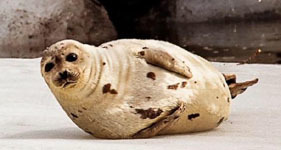 3/15 – Green Island, HRM152: In mid-afternoon, a juvenile harp seal was spotted on floating ice just north of the Green Island Bridge. Later, the seal hauled out on anchored ice, perfect for photographs. The seal was lying in its typical resting “banana-like” pose that observers often mistake for a seal in distress. (Photo of harp seal courtesy of Robb Bagnato)
3/15 – Green Island, HRM152: In mid-afternoon, a juvenile harp seal was spotted on floating ice just north of the Green Island Bridge. Later, the seal hauled out on anchored ice, perfect for photographs. The seal was lying in its typical resting “banana-like” pose that observers often mistake for a seal in distress. (Photo of harp seal courtesy of Robb Bagnato) 3/9 – Annandale, HRM 99: I was at Montgomery Place today on the campus of Bard College, where I was a site horticulturist 25 years ago, enjoying the sunshine before the ice, rain and snow arrived. Immature bald eagles were out as well enjoying the day. When I later looked at the photos I had taken on my computer, I realized that two eagles that were going talon-to-talon were banded. One was a Maine bird (red band) and the other was a Massachusetts eagle (gold band). While it is not unusual to get photos of eagles with bands, it is unusual to have two eagles interacting from two different states. I plan to submit the photos to my contacts in Maine and Massachusetts to discover their origin. (Photo of banded bald eagles courtesy of Kathryn Zvokel-Stewart)
3/9 – Annandale, HRM 99: I was at Montgomery Place today on the campus of Bard College, where I was a site horticulturist 25 years ago, enjoying the sunshine before the ice, rain and snow arrived. Immature bald eagles were out as well enjoying the day. When I later looked at the photos I had taken on my computer, I realized that two eagles that were going talon-to-talon were banded. One was a Maine bird (red band) and the other was a Massachusetts eagle (gold band). While it is not unusual to get photos of eagles with bands, it is unusual to have two eagles interacting from two different states. I plan to submit the photos to my contacts in Maine and Massachusetts to discover their origin. (Photo of banded bald eagles courtesy of Kathryn Zvokel-Stewart)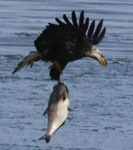 3/9 – Croton Point, HRM 35: I watched as an adult bald eagle swooped down and grabbed a large fish out of Croton Bay. It was a gizzard shad, and its size seemed to be about at the limit of the eagle’s capacity to carry. This was a “new” adult, a four-year-old eagle just getting its white head and tail feathers denoting maturity. After snagging the fish, the eagle flew off pursued by a shrieking herring gull demanding a share. (Photo of bald eagle with gizzard shad courtesy of Roger Pare)
3/9 – Croton Point, HRM 35: I watched as an adult bald eagle swooped down and grabbed a large fish out of Croton Bay. It was a gizzard shad, and its size seemed to be about at the limit of the eagle’s capacity to carry. This was a “new” adult, a four-year-old eagle just getting its white head and tail feathers denoting maturity. After snagging the fish, the eagle flew off pursued by a shrieking herring gull demanding a share. (Photo of bald eagle with gizzard shad courtesy of Roger Pare)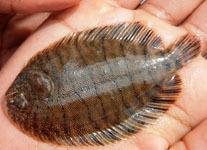 3/10 – Hudson River Watershed: This week’s fish is the hogchoker (Trinectes maculatus), species number 222 (of 228) on our watershed list of fishes. (If you would like a copy of our list, e-mail:
3/10 – Hudson River Watershed: This week’s fish is the hogchoker (Trinectes maculatus), species number 222 (of 228) on our watershed list of fishes. (If you would like a copy of our list, e-mail: 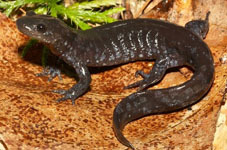 3/11 – Hudson River Watershed: Why Did the Amphibian Cross the Road? Have you ever witnessed large numbers of salamanders and frogs crossing the road on rainy spring nights? Ever wonder where they came from and where they're going?
3/11 – Hudson River Watershed: Why Did the Amphibian Cross the Road? Have you ever witnessed large numbers of salamanders and frogs crossing the road on rainy spring nights? Ever wonder where they came from and where they're going?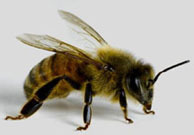 3/14 – Dutchess County, HRM 95: It was a warm 57 degrees F today, and when I was at a stoplight near Red Hook, a honey bee landed on my side mirror to rest. The bee then flew off, hopefully to find witch hazel or some early bulbs. (Photo of honey bee courtesy of Debbie Hadley)
3/14 – Dutchess County, HRM 95: It was a warm 57 degrees F today, and when I was at a stoplight near Red Hook, a honey bee landed on my side mirror to rest. The bee then flew off, hopefully to find witch hazel or some early bulbs. (Photo of honey bee courtesy of Debbie Hadley) 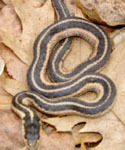 3/15 – South Salem, HRM 44: I found an eastern ribbon snake (Thamnophis sauritus) while I was out looking for deer antlers today. The snake was still pretty sluggish, and I was surprised to see it out this early. I watched the snake for 15 minutes – initially, I wasn't even sure it was alive –and finally its tongue darted out. But, the snake did not move even when I moved some leaves, so I could get a better look. (Photo of eastern ribbon snake courtesy of John Peters)
3/15 – South Salem, HRM 44: I found an eastern ribbon snake (Thamnophis sauritus) while I was out looking for deer antlers today. The snake was still pretty sluggish, and I was surprised to see it out this early. I watched the snake for 15 minutes – initially, I wasn't even sure it was alive –and finally its tongue darted out. But, the snake did not move even when I moved some leaves, so I could get a better look. (Photo of eastern ribbon snake courtesy of John Peters)